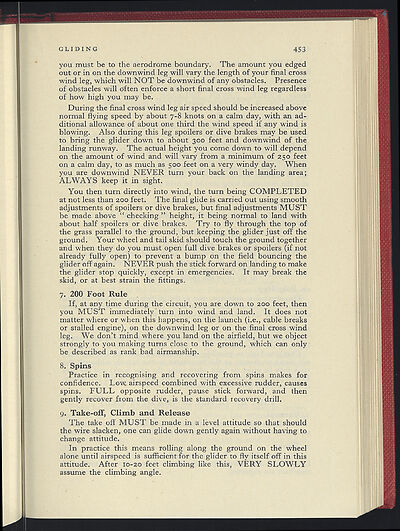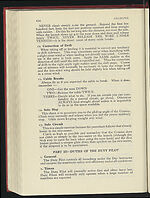1957-58
(471)
Download files
Complete book:
Individual page:
Thumbnail gallery: Grid view | List view

GLIDING 453
you must be to the aerodrome boundary. The amount you edged
out or in on the downwind leg will vary the length of your final cross
wind leg, which will NOT be downwind of any obstacles. Presence
of obstacles will often enforce a short final cross wind leg regardless
of how high you may be.
During the final cross wind leg air speed should be increased above
normal flying speed by about 7-8 knots on a calm day, with an ad-
ditional allowance of about one third the wind speed if any wind is
blowing. Also during this leg spoilers or dive brakes may be used
to bring the glider down to about
300
feet and downwind of the
landing runway. The actual height you come down to will depend
on the amount of wind and will vary from a minimum of
250
feet
on a calm day, to as much as
500
feet on a very windy day. When
you are downwind NEVER turn your back on the landing area;
ALWAYS keep it in sight.
You then turn directly into wind, the turn being COMPLETED
at not less than
200
feet. The final glide is carried out using smooth
adjustments of spoilers or dive brakes, but final adjustments MUST
be made above " checking " height, it being normal to land with
about half spoilers or dive brakes. Try to fly through the top of
the grass parallel to the ground, but keeping the glider just off the
ground. Your wheel and tail skid should touch the ground together
and when they do you must open full dive brakes or spoilers (if not
already fully open) to prevent a bump on the field bouncing the
glider off again. NEVER push the stick forward on landing to make
the glider stop quickly, except in emergencies. It may break the
skid, or at best strain the fittings.
7. 200
Foot Rule
.
If, at any time during the circuit, you are down to
200
feet, then
you MUST immediately
-
turn into wind and land. It does not
matter where or when this happens, on the launch (i.e., cable breaks
or stalled engine), on the downwind leg or on the final cross wind
leg. We don't mind where you land on the airfield, but we object
strongly to you making turns close to the ground, which can only
be described as rank bad airmanship.
8. Spins
Practice in recognising and recovering from spins makes for
confidence. Low, airspeed combined with excessive rudder, causes
spins. FULL opposite rudder, pause stick forward, and then
gently recover from the dive, is the standard recovery drill.
9.
Take-off, Climb and Release
The take off MUST be made in a level attitude so that should
the wire slacken, one can glide down gently again without having to
change attitude.
In practice this means rolling along the ground on the wheel
alone until airspeed is sufficient for the glider to fly itself off in this
attitude. After
t0-20
feet climbing like this, VERY SLOWLY
assume the climbing angle.
f
I
you must be to the aerodrome boundary. The amount you edged
out or in on the downwind leg will vary the length of your final cross
wind leg, which will NOT be downwind of any obstacles. Presence
of obstacles will often enforce a short final cross wind leg regardless
of how high you may be.
During the final cross wind leg air speed should be increased above
normal flying speed by about 7-8 knots on a calm day, with an ad-
ditional allowance of about one third the wind speed if any wind is
blowing. Also during this leg spoilers or dive brakes may be used
to bring the glider down to about
300
feet and downwind of the
landing runway. The actual height you come down to will depend
on the amount of wind and will vary from a minimum of
250
feet
on a calm day, to as much as
500
feet on a very windy day. When
you are downwind NEVER turn your back on the landing area;
ALWAYS keep it in sight.
You then turn directly into wind, the turn being COMPLETED
at not less than
200
feet. The final glide is carried out using smooth
adjustments of spoilers or dive brakes, but final adjustments MUST
be made above " checking " height, it being normal to land with
about half spoilers or dive brakes. Try to fly through the top of
the grass parallel to the ground, but keeping the glider just off the
ground. Your wheel and tail skid should touch the ground together
and when they do you must open full dive brakes or spoilers (if not
already fully open) to prevent a bump on the field bouncing the
glider off again. NEVER push the stick forward on landing to make
the glider stop quickly, except in emergencies. It may break the
skid, or at best strain the fittings.
7. 200
Foot Rule
.
If, at any time during the circuit, you are down to
200
feet, then
you MUST immediately
-
turn into wind and land. It does not
matter where or when this happens, on the launch (i.e., cable breaks
or stalled engine), on the downwind leg or on the final cross wind
leg. We don't mind where you land on the airfield, but we object
strongly to you making turns close to the ground, which can only
be described as rank bad airmanship.
8. Spins
Practice in recognising and recovering from spins makes for
confidence. Low, airspeed combined with excessive rudder, causes
spins. FULL opposite rudder, pause stick forward, and then
gently recover from the dive, is the standard recovery drill.
9.
Take-off, Climb and Release
The take off MUST be made in a level attitude so that should
the wire slacken, one can glide down gently again without having to
change attitude.
In practice this means rolling along the ground on the wheel
alone until airspeed is sufficient for the glider to fly itself off in this
attitude. After
t0-20
feet climbing like this, VERY SLOWLY
assume the climbing angle.
f
I
Set display mode to:
![]() Universal Viewer |
Universal Viewer | ![]() Mirador |
Large image | Transcription
Mirador |
Large image | Transcription
| Games and sports in the army > 1957-58 > (471) |
|---|
| Permanent URL | https://digital.nls.uk/248857120 |
|---|
| Description | 'Games and Sports in the Army' was an annual publication produced by the British War Office between the 1930s and 1960s. This included the Second World War. It outlines the rules and regulations for games and sports played by members of the armed forces. It features names and photographs of team members, and examples of contemporary advertising. |
|---|---|
| Shelfmark | GWB.52 |

